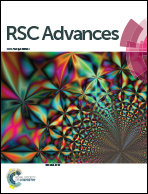Synthesis of porous microspheres composed of graphitized carbon@amorphous silicon/carbon layers as high performance anode materials for Li-ion batteries
Abstract
We report in situ growth of amorphous silicon/carbon (Si/C) layers on graphitized carbon black (GCB) particles in porous microspheres (PMs) for formation of novel GCB@Si/C PMs as high performance anode materials. The preparation included spray drying, KOH activation and chemical vapor deposition at 900 °C, and used methyltrichlorosilane as both the Si and C precursor, which is a cheap byproduct in the organosilane industry. The obtained samples were characterized by X-ray diffraction, thermogravimetric analysis, nitrogen adsorption, transmission electron microscopy, and scanning electron microscopy. Compared with the bare GCB PMs, the GCB@Si/C PMs showed a significantly enhanced electrochemical performance with high lithium storage capacity and excellent cycling stability (the discharge capacity of GCB@Si/C-3 PMs and GCB@Si/C-6 PMs is maintained at 587.2 and 729.7 mA h g−1 after 200 cycles at a current density of 100 mA g−1), because the unique interconnected porous structure within the microspheres could absorb a large portion of Si volume change during Li insertion and extraction reactions, promote the diffusion of Li-ion and electrolyte solution, hinder the cracking or crumbling of the electrode, and additionally, the GCB and amorphous C provide high conductive electron pathway. This work opens a new way for fabrication of Si/C nanocomposites as anode materials for Li-ion batteries.


 Please wait while we load your content...
Please wait while we load your content...